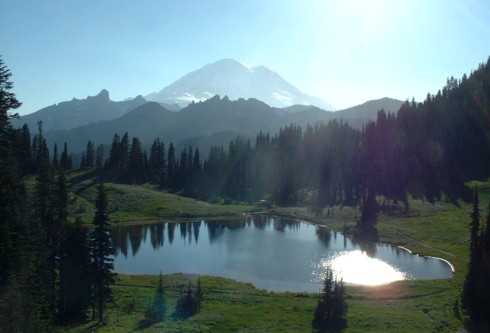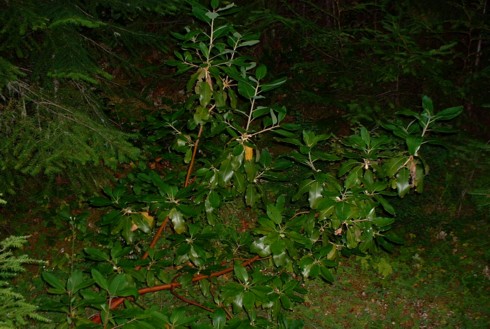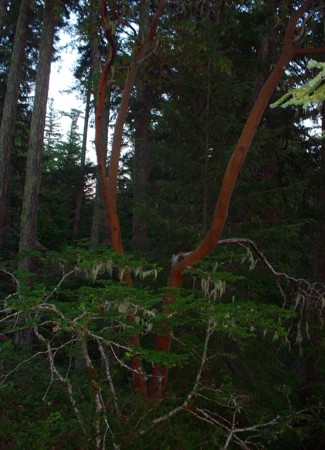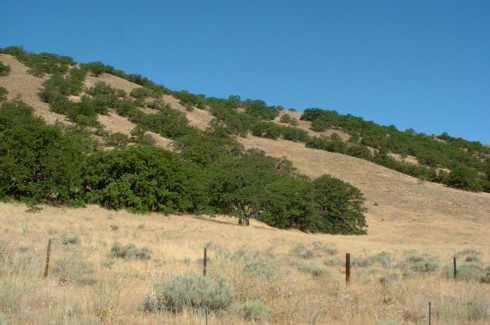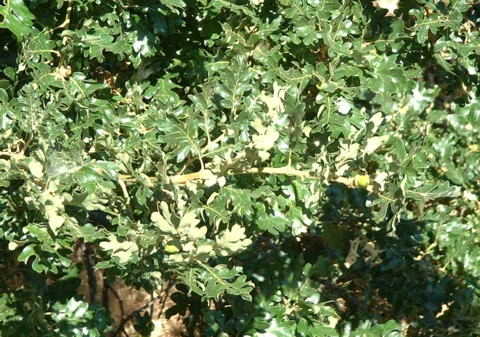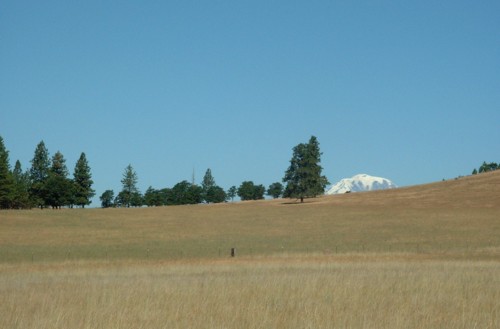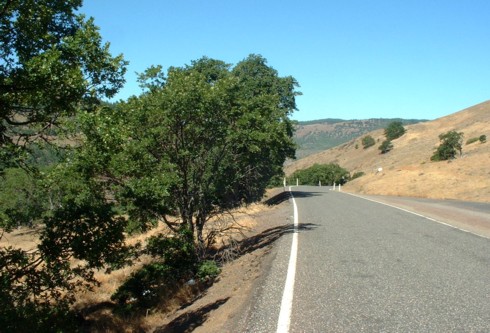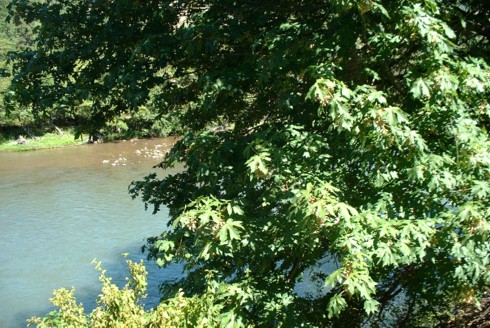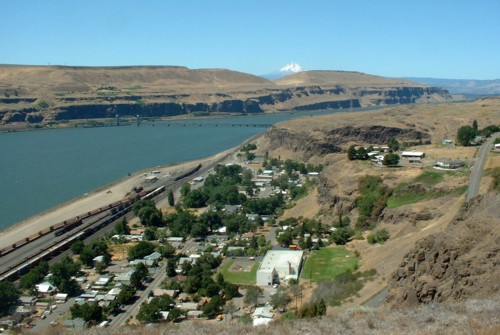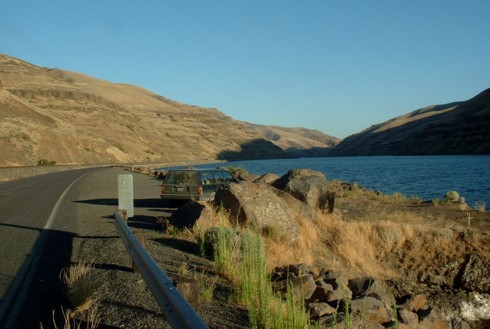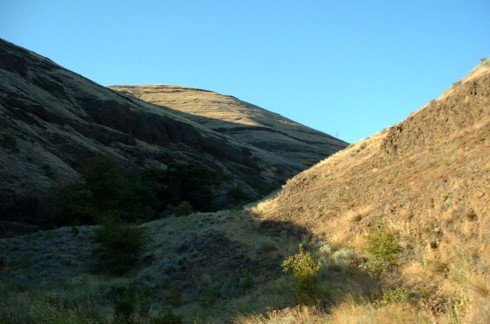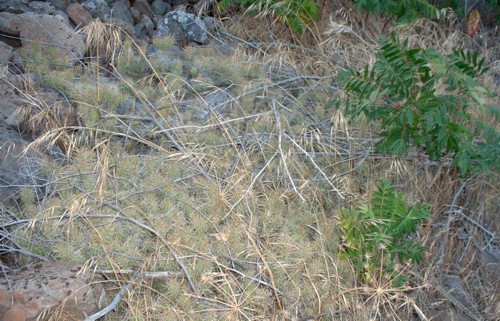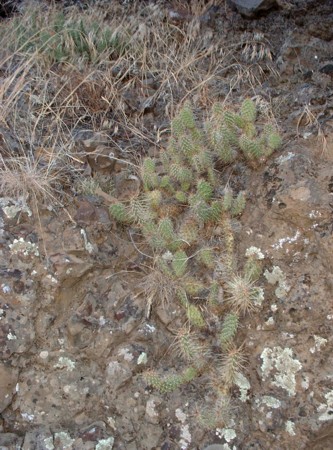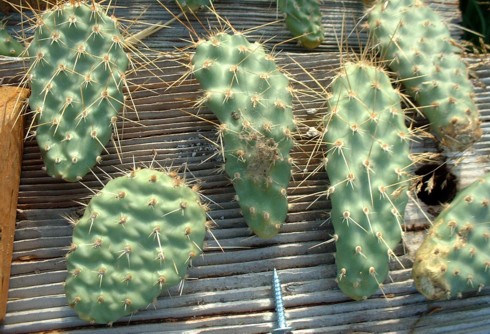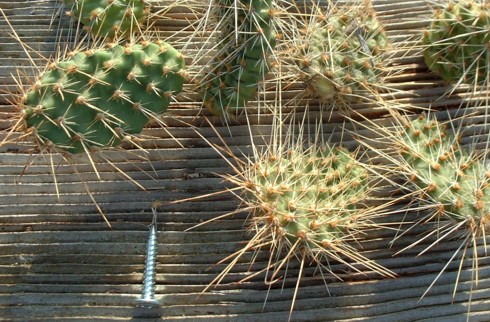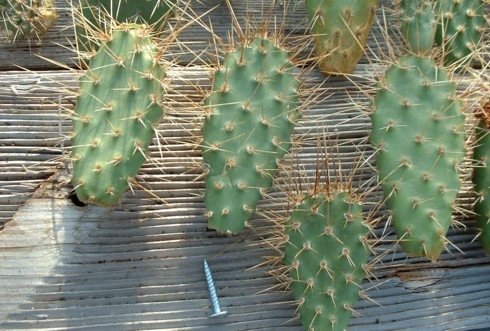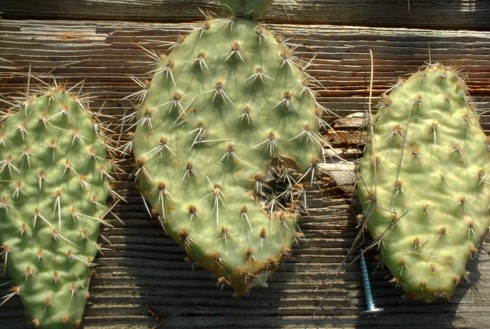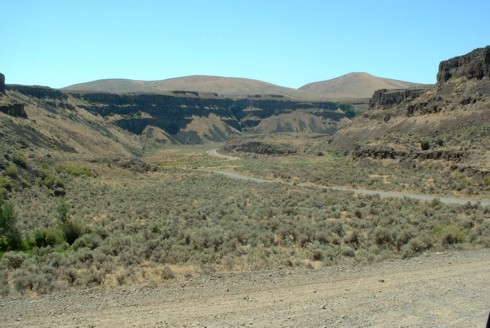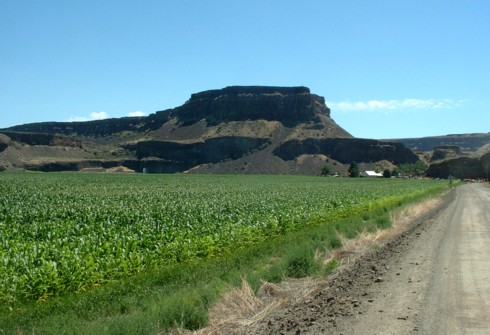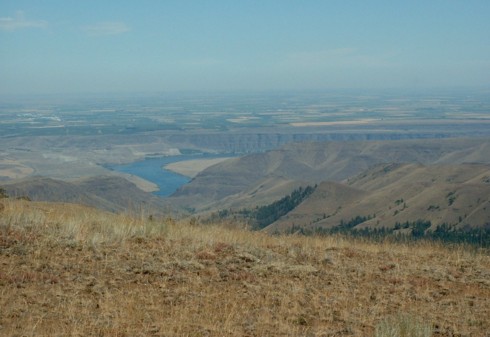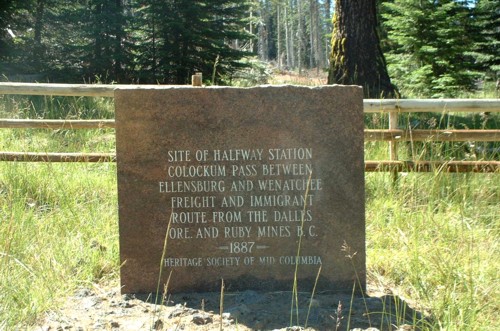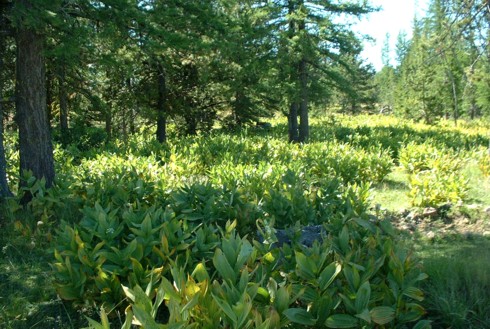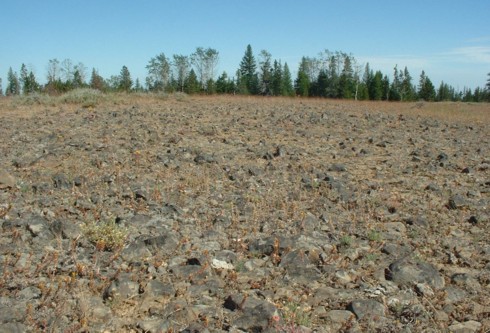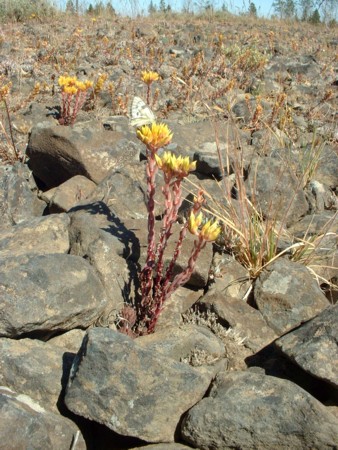|
July 19-21, 2005 In late July of 2005 summer finally arrived in the Northwest, and I decided to do a short collection trip to eastern Washington. My main purpose was to collect some cactus cuttings of Opuntia plants from various locations in eastern Washington, and see and photograph a few other interesting plants I had heard about, and possibly collect a few seeds. Officially, Washington has four taxa of native cacti, three of which belong to the genus Opuntia or prickly pears. All of the Opuntias usually have yellow flowers, though I have read of occasional pink flowered plants in central Washington, and I don't think it's out of the question that some pink forms of O. polyacantha may be found in the southeast part of the state. All four of these cacti are found outside of Washington as well; in fact they are native to many areas of the West.
So at about three in the afternoon, after many delays, I finally set out from Poulsbo. On the way down, I drove over Cayuse Pass, and got this picture of Tipsoo Lake and Mt. Rainier.
As I headed east, the first stop of botanical interest was a legendary high altitude grove of madrona trees (Arbutus menziesii) that I had heard of from Mr. Allen Hirsh. They are on a rocky outcrop just above US 12 on the approach to White Pass, at an altitude of 2,500 feet. At first I could find only one small plant. Then eventually I found one large, old tree and a number of 5 - 20 year old plants. Obviously because of the altitude and inland location, this provenance would be the most ideal for anyone desiring a cold-hardy madrona. It is not the right time of year for seeds, and it did not look like they had even flowered at all or that seed was ripening. This species is also impossible to propagate from cuttings. In any case, I just wanted to see and photograph them, since it is remarkable that this population exists so far east of the rest of this tree's range in Washington.
My next stop was then to look for a population of Opuntia on US 12 just west of the SR 410 junction, not far from Naches. However, I could not find them, so no pictures. Then I camped for the night in the hills above Naches. Early the next morning I drove up and down the Canyon Rd. between Ellensburg and Yakima. I had a tip from Mike Lee that some Opuntia colonies had been removed by the DOT, and it would be a good place to look for more plants. I couldn't find them, however, so no pictures of them either! I did find a lot of Balsamorhiza saggitatta here, a rather exotic-leafed native plant that I might have liked to collect seeds from, but no seeds were left on those plants, or anywhere that I found this species. I had breakfast in Toppenish, and the waiter told me that he "used to find" cacti all along the Yakima River. However, they grow (grew?) in gravel bars under the cottonwood trees, not on the rocky hillsides as they do farther east in Washington. So I may have been looking in the wrong place in the Yakima River canyon, but the area is not so far away that I can't get back to it sometime. After this I headed south on US 97 through the Yakama Indian Reservation. To my surprise I saw Oregon white oak (Quercus garryana) everywhere. I had known they were native to this area, but I did not expect them to be so numerous or so large, or to be peppering the hillsides the same way they do in California. As you approach Satus Pass, it feels like you are driving through the mountain foothills of California, only instead of digger pines (Pinus sabiniana) you have ponderosa pines (P. ponderosa). I was also surprised that they grew all the way to the top of the Pass (3,145') where the pine and oak woodland became mixed with denser growth of Douglas fir (Pseudotsuga menziesii) and western larch (Larix occidentalis). So I would think Q. garryana is probably the cold-hardiest Western oak. This is the easternmost part of its range, but it is native as far north as Naniamo, BC west of the Cascades. Ceanothus velutinus, an evergreen shrub that may grow into a small tree west of the Cascades, was also common in this area.
Mt. Adams and Quercus garryana, with Pinus ponderosa in Klickitat County. Upon reaching Goldendale I turned west, thinking perhaps I would see some Opuntias or even Pediocactus nigrispinus in the canyon between Goldendale and Klickitat. Klickitat County is known to have some very robust forms of Pediocactus nigrispinus, but I really have no idea where they are. They may be higher up than where I was looking, or perhaps they are along the Columbia River. It is in this California-like canyon that I almost expected to find some Opuntias, but did not. I did see a hoary marmot, though.
Then I got another surprise. In those hot canyons was one of the eastern outposts of bigleaf maple (Acer macrophyllum), which grew as rather small stunted trees only on sheltered valley bottoms. More recently I have found that this species also inhabits the Entiat Valley and Peshatin Creek Valley in Eastern Washington. Seeds were not quite ripe, but it would be a good place to collect for someone desiring a heat tolerant Acer macrophyllum.
After not finding any cacti in that area, I drove east on SR 14 from Lyle. I had read there were large colonies of Opuntia fragilis along the Columbia River near Wishram, and I had even seen pictures large colonies of them growing right along the highway. However, in spite of a thorough search in which I stopped the car in quite a few places to look around, I did not find them at all. The ones along the highway must have been removed, since I couldn't possibly have missed a colony that big and conspicuous even if the plants were not in bloom. So I don't have any pictures of that either.
Wishram, WA with the Columbia River and Mt. Hood in the background. I then drove through the Tri Cities (after stopping to get some ice cream, which I needed since it was 98°F) north on US 395. Then just for fun I took a little side trip down Smith Canyon Rd. thinking that a canyon might be a good place to find some cacti. But it turned out to be kind of a lame excuse for a canyon with no cacti (though a nice drive). My next place to check out was just southwest of Connell, where a stop on the railway had been given the name of "Cactus" (I discovered this by going to topozone.com and doing a search for a place called "cactus" in Washington! I also found Cactus Island in the San Juans. Anyways...) This spot turned out to be inaccessible. I got to a closed gate that said no trespassing, property of the railroad. Apparently Cactus, Washington is no longer an establishment of public importance. (That's too bad... maybe I'll found a city and call it "Cactus".) So at this point I was quite disappointed, being 0 for 4 thus far in my quest to find native cacti. I then drove east to Kahlotus, from which point I was going to drive southeast on SR 261 to see Palouse Falls (which I had never seen even after driving back and forth between Pullman and Olympia the whole time I attended WSU) and then on to the Lewiston area. But at the beginning of the highway there was a sign saying "Road Closed Across Dam", which was a little annoying, but at least they warned me before I drove down there, thought I. I knew there were not many cacti, if any at all, in the major wheat production area between Washtucna and Pullman, so I drove right on through it without stopping to look at anything. My next significant stop was a place called the Devil's Eye, a natural bridge in the rock in a side canyon high above the Snake River Canyon. In the past, my friend Joe Galloway hiked into that area (He just wanted to be able to say "I peed in the Devil's eye!") and noted that there were some cacti, so Joe took me to the area in 2001 but I did not collect very many cuttings. This time I returned to find that access from the top of that side canyon (where we had come before) was more difficult than it had been, so I decided to drive down through nearby Steptoe Canyon, an 11-mile descent into the Snake River Canyon, and then approach the Devil's Eye area from the bottom, along the Snake River. (There may be cacti in Steptoe Canyon as well, but if so, they are not conspicuous - and, having thoroughly explored Nisqually John Canyon, which is between the two, I can say that some of those canyons do not have cacti at all.)
The Snake River northwest of Clarkston.
The canyon that I explored along the Snake River. It is larger and steeper than it appears in this picture. This approach from the bottom turned out to be a great idea. It took a bit of guesswork to figure out which canyon was the right one without a good map, and when I returned home and checked some maps, it turned out I was not really in the same canyon I intended to explore. The canyon of the Devil's Eye is called Yakawawa Canyon, but I was actually in a smaller canyon just to the south of that. Fortunately I got lucky anyways: once I hiked in there I found many large mats of cacti just a couple hundred feet up! I collected cuttings from three distinct forms, which I shall call the "large pad form", "small pad form" (with super spines I might add!!), and golden form, which had intermediate size pads and sort of golden new growth. All of them had great bright green color, a little yellow but not yellow enough to look sickly. So I think they will all make great garden plants, and yellow flowers can probably be expected. They are all forms of O. columbiana, I suppose, though they do not look like the ones in central Washington.
Large mats of cacti with sumac at right.
Cacti dangling from the basaltic rock cliffs of the canyon.
The "large pad form". That is a 1" lath screw for scale.
The "small pad form". To me this one closely resembles O. erinacea.
The golden form. I may call this one O. columbiana 'Devil's Eye'. Then it was on to one more place that I knew cacti could be found. This site is a few miles southwest of Asotin on George Creek Rd., a site that I stumbled across quite by accident in my college days (I have no recollection of what I was down there for). These cacti are true O. polyacantha: there is nothing fragile about them, and the pads are very flattened, having that sort of almost diamond-shape to them, and they do not look at all like O. fragilis or O. columbiana. They are also much larger, mostly 3 - 5" long, and look like forms of O. polyacantha from Idaho, Montana and Alberta. The plants were not as robust as they were when I saw them several years ago, having lost some of their height (how, I can't imagine) and being a sickly shade of yellow. I collected cuttings from two forms, one with smaller pads and one with larger pads - hopefully I can get them to perk up. At this point it was a bit dark to be taking good pictures.
George Creek cacti, the only O. polyacantha I have found in Washington. From hints and tips that I have heard, I believe that the region between Asotin, WA, Enterprise, OR, and Kamiah and Riggins, ID may have many interesting, larger forms of O. polyacantha and O. columbiana, and perhaps some with flower colors other than yellow. There is even a mountain by the Snake River called Cactus Mountain, in the very northeast corner of Oregon. Someone with a lot of spare time and a hummer should explore this area for Opuntias. At least one species/form of Pediocactus are also found here. Access to this area is very difficult, as it is full of tortuous mile-deep canyons, high snow-capped peaks, and wandering drunken redneck-logger-hicks on four-wheelers. After getting some more ice cream in Clarkston (at 9:45 it was still 93 degrees), I returned to Pullman to stay with some friends that night. While there I checked up on a cactus (O. polyacantha) that used to grow behind an apartment complex that was next to my old house. It looked very sad and beat up with only a few good pads left. I took just a couple to ensure that this plant was preserved in some form. I talked to Dave (whom we used to call "Hip-dawg" while I lived there) and he said that the plant might have come from Montana originally, and that the reason for its demise was that it had been run over by vehicles quite a few times. The next morning I had a great breakfast in Colfax (if you are ever there, stop by the Top Notch Café), and then drove west again on SR 26, then I turned north on SR 17. This is the major agricultural center of Eastern Washington where numerous crops are irrigated with water from the Columbia River, which conveniently loops around a large area of dry and relatively low desert. I wanted to explore the hills west of Ephrata, since it seemed like an interesting place, and Pediocactus nigrispinus has been reported from that area. I somehow goofed up and went north of my intended route, however, and after passing through a low pass in the hills (with no cacti), I found myself in flat wheatfields once again. Then I turned west and found myself on a gravel road that dropped quickly into a deep and scenic canyon, with sheer vertical walls of basaltic rock. No cacti here either. Then the road plunged abruptly (again) into a deep, broad canyon that was almost completely filled with irrigated croplands. It was a very beautiful area, though, and probably worth further exploration. And finally I came out on SR 28 approaching Wenatchee.
The last place I really wanted to look for cacti was at Malaga, east of Wenatchee but on the west side of the Columbia River. I knew that a collection of O. columbiana had been made from that area. But after driving around a little bit, I did not find any cacti, and I soon discovered that access to the areas closest to the river was difficult, since the area was taken over by large-scale agricultural/industrial development of various kinds. That could well be where the cacti are, considering that in central Washington they are usually found right along the rivers. But I did not feel like getting out of the car to poke around too much, since it was in the upper 90s again. So I gave up on that and kept driving down the river until the road turn west again, into the mountains. I then drove up Colockum Pass, a route used by settlers between Ellensburg and Wenatchee in the days of yore. In retrospect I probably would not do this again without a 4X4, since the road was very rocky in places, including about a three-mile stretch of giant 5" gravel with embedded boulders. However since my car had new tires and good ground clearance, I figured what the heck, I am up here now so I will just keep going. Pediocactus nigrispinus is known to grow near in the Colockum Range somewhere, but I have no idea just where. I half expected to see it in the numerous rock fells on the hot, windswept ridges, but it probably does not grow as high up as where I was looking. (If it did... that would be something!!) Incredible views were to be had a bit below the top. Near the top of the pass (5,350'), the country is beautiful and flat. False hellebore (Veratrum viride) was abundant in wetter areas, and many plants I was not familiar with grew where it was dry. Botanically it was a very interesting area. So in spite of being a bit time consuming and rough on my car, the drive was certainly worth it.
Veratrum viride near the top of Colockum Pass.
The rock fells where I did not find Pediocactus nigrispinus. (Actually... that could be said about a lot of places!)
Then after getting a milkshake at "U-Tote-Em" Burgers in Ellensburg, I drove back over the mountains to Poulsbo without making any more exciting stops. |
|
In reminiscing on this trip, several points come to mind.
First of all, cacti in Eastern Washington may be "widespread" but they are certainly not common. They are absent from most areas that seem to have the appropriate soil, aspect, and other conditions for them, and are probably limited to a few selected areas. Pediocactus nigrispinus is now found only in very remote areas. Secondly (and really a sub-point of my first point), I failed to find any cacti except where I had already found them before. Even those that I "knew" about were sufficiently difficult to find that, to stick with my schedule, I had to give up the search. So I will probably not look for cacti in this way again, unless I get specific tips on EXACTLY where they are. The trip certainly was not a waste, as I did get some cuttings, and it was still fun to get out there and see other interesting plants and scenery. I've also looked around the Sequim area a few times, where I know O. fragilis is native in WESTERN Washington, and I still have yet to find it there. Again I might just give it up for a while and pursue tips on just where to find them. Clearly the best time to find cacti is when I am not looking for them. Thirdly, I wonder if anyone has ever done a detailed botanical study of these cacti - probably not. There are so many different forms and variations, coming from various remote locations, that one could easily devote a life's work to studying, mapping, and classifying the native cacti of the Northwest. Perhaps it will be determined that some of these various colonies do belong to O. erinacea, or that new species or subspecies would be named. And lastly, in a couple places it looked like native populations of cacti had been annihilated because they were in the way of industrial development or recreational facilities, or for other unknown reasons. Doubtless many colonies of this species have been lost to agriculture, especially where orchards and other irrigated lands have been established near rivers. This is especially true of those colonies in the Yakima and western Columbia Basins in Washington. And of course, many must have been lost decades ago when dams were built along the Columbia and Snake Rivers. The conservation status of O. fragilis is supposedly "under review", but in my opinion it may be rare enough already to warrant rather strict protection from destruction in its native habitat. It has been added to the Washington State Rare Plant List, but its true scarcity is not known. (O. columbiana and O. polyacantha in the southeast corner of Washington seem a little less likely to warrant this protection, since they are found on mostly unusable land.) I haven't been able to find out the conservation status of Pediocactus nigrispinus; I would guess it is protected, and if not, it certainly should be. All of these cacti should also be responsibly collected (i.e. by taking cuttings or seeds rather than entire plants), propagated, and grown more in gardens so that the general public will think of them as valuable plants that are very unique for our region. Ultimately it is through cultivation and public interest that the preservation of rare plants is ensured. More information on Eastern Washington Cacti:
|
